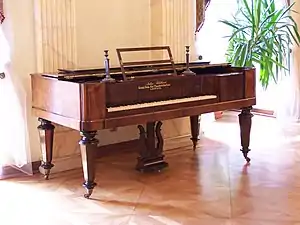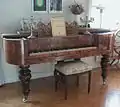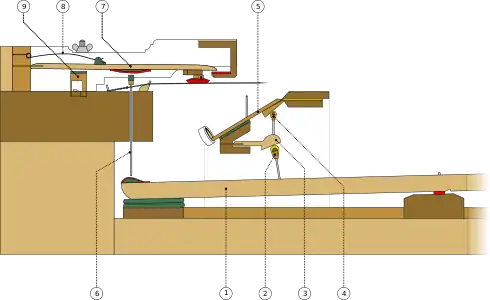
The square piano is a type of piano that has horizontal strings arranged diagonally across the rectangular case above the hammers and with the keyboard set in the long side, with the sounding board above a cavity in the short side. It is variously attributed to Silbermann and Frederici and was improved by Petzold and Babcock. The English and Viennese square pianos were built in many different designs, including within the action as well as general appearance, from roughly 1760. Because of the competitive industry and relative youth of the instrument design itself, experimentation ensued in the early years, creating a range of moderators (sound-altering effects) and other technical devices (knee levers; hand stops) not seen today.[1]
In London, the explosion of the trade is generally attributed to the maker Zumpe. The overwhelming popularity of his instruments was due to inexpensive construction and price.
Over time, square pianos were built in larger sizes with more keys and a wider range; by the 1830s, square grand pianos predominated, with changes to their internal mechanisms and construction that produced larger sounds and used higher string tensions. Square pianos were the most popular keyboard instrument of the late 18th century, and the later square grand pianos enjoyed great popularity through the mid- and late-19th century. They were gradually replaced by upright pianos, which had a smaller footprint and larger sound. Square pianos were owned by everyone from George Washington and Thomas Jefferson to Marie Antoinette[2] and Jane Austen.[3]
In the 1860s, more extensive metal frames were developed for square grand pianos, meaning that higher string tensions and therefore greater volumes were possible; however the size increases meant that the upright piano design was more economical, and so the upright replaced the square as the most common home instrument. Built in quantity through the 1890s in the United States, Steinway's celebrated iron-framed, overstrung square grands were more than two and a half times the size of Zumpe's wood-framed instruments that were successful a century before. Whilst many view square pianos as a 'proto-piano', because they do not have the range, volume or delicacy of touch available on modern instruments, they have a sound and playability all their own, and should be treated as an altogether different instrument to the modern piano.[4]
Gallery

 Square grand piano (though this example is not exactly rectangular)
Square grand piano (though this example is not exactly rectangular) Square grand piano with open lid
Square grand piano with open lid Swedish painting of woman playing a square piano.
Swedish painting of woman playing a square piano. English double action with check, c. 1830 (developed from Geib, 1786
English double action with check, c. 1830 (developed from Geib, 1786 American single action with overdamper, c. 1870 (developed from Petzold, 1809)
American single action with overdamper, c. 1870 (developed from Petzold, 1809) Zumpe single action, 1766
Zumpe single action, 1766 Erard double pilot action, 1790 "Zumpe's second action" c. 1788
Erard double pilot action, 1790 "Zumpe's second action" c. 1788 Square piano C. Oehler Stuttgart, 1870s
Square piano C. Oehler Stuttgart, 1870s
See also
- Finchcocks, a collection of early keyboard instruments in Kent which has many original square pianos.
References
- ↑ Lancaster, Geoffrey (2015). The First Fleet Piano: Volume One: A Musician's View. Acton, Australia: Australia National University Press. ISBN 9781922144645.
- ↑ "Marie Antoinette's Piano". The Cobbe Collection. Retrieved 16 March 2018.
- ↑ Boyle, Laura. "Jane Austen's Piano". Jane Austen World. Retrieved 16 March 2018.
- ↑ Lancaster, Geoffrey (2015). The First Fleet Piano: Volume One: A Musician's View. Acton, Australia: Australia National University Press. ISBN 9781922144645.
- Goold, Madeline, Mr. Langshaw's Square Piano, BlueBridge, 280 pages